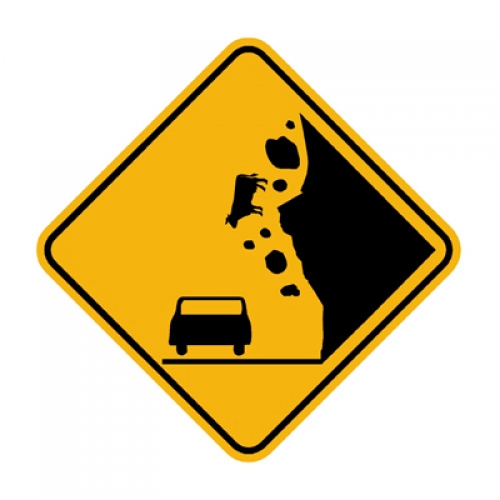Ecce est percipi
So, have we been flogging a dead horse? The idea that things only exist in our minds just doesn’t feel right – it seems to question the solidity of the very ground beneath our feet. This same frustration is reflected by Samuel Johnson when he kicked the rock.
Here’s how his biographer, James Boswell, remembers the discussion with his friend as they were leaving church one Sunday way back in 1763 :
We stood talking for some time together of Bishop Berkeley’s ingenious sophistry to prove the non-existence of matter, and that every thing in the universe is merely ideal. I observed, that though we are satisfied his doctrine is not true, it is impossible to refute it. I never shall forget the alacrity with which Johnson answered, striking his foot with mighty force against a large stone, till he rebounded from it, “I refute it thus”.
What was being refuted by the pain shooting through his foot was Bishop Berkeley’s principle of Immaterialism, namely that “to be is to be perceived” – or “esse est percipi” in Latin (because clever stuff is best stated in Latin).
Berkeley’s claim that “anything imperceptible does not exist” sounds like pure baloney – I mean when did black holes or atoms begin to exist? When their possible existence was first proposed? When we finally managed to take a photograph of one?
Unfortunately Johnson’s famous refutation fails. It has however been classified amongst well known logical fallacies as the “appeal to the stone” or “argumentum ad lapidem” – big up Samuel Johnson!
Intellectual Honesty
Logical fallacies are errors in reasoning that we often make because they seem solid, they appeal to our common sense. Our brains are naturally attracted to certain irrational ways of thinking. The most frequent examples include : the ad hominem fallacy, the bandwagon fallacy or the appeal to authority – all of which are examples of how the social sphere affects our ability to reason effectively.
Kicking a rock doesn’t actually counter the idea that perception and existence are somehow linked – seeing as my experience of the rock is what determines its apparent reality. Johnson’s flawed point doesn’t mean he’s wrong though, just that the difference between something that doesn’t exist and something that cannot be detected is still hazy.
Kastrup is also guilty of poor reasoning, or being slightly dishonest in his arguments against materialism. For example cherry picking scientific questions that support his case whilst neglecting those that challenge it. Like using a popular interpretation of the “observer principle” in quantum physics, and ignoring the consensus model about brains and perception.

What the rock does highlight is the fact that it cannot be ignored – or that rocks are ignored at your peril. We must deal with what we see. Exploring hidden mysteries based purely on speculation, or armchair philosophy, can often be interesting and sometimes even useful, but it is circular and incomplete. Ideas come alive when they engage with the world. Do they produce accurate predictions? Do they lead to conflict or transformation?
There may be as yet undetected teapots orbiting some alien planet. A few of these teapots may even contain tiny fire-breathing dragons, or the answers to all of life’s mysteries, which would be fantastic.
Finding those particular teapots would certainly add to the sum of human understanding. So if you can imagine without leaving your armchair, why they might exist and where they are, we want to know. But until we do find them, living our lives based on what the teapot dragons want would be unwarranted.
Hardcore idealists imagine that the yet undetected creative foundation of the universe is just like us. Our experience of the world is a mental state, so therefore that’s all there is to existence. But why? Why should my limits be the limits of the universe? Just because my experience of a tree is demonstrably subjective, limited and probably incorrect, in no way proves that trees don’t exist. Or that no tree-like phenomenon can exist in my absence.
The Hard vs the Real
The notion that mind is somehow at the basis of everything has become popular again thanks to the “hard problem of consciousness”. This is a problem popularized by the philosopher David Chalmers. It’s all about how difficult it is for us to accept that mind could arise from matter.
We can more or less grasp the idea that rocks and chairs are things that appear in our consciousness – in other words that matter is something we experience. But the idea that objects can be squished together in such a way as to produce thoughts and feelings just feels too weird.
Why should atoms, molecules and cells arranged in the form of brain matter suddenly produce hopes and dreams?
So of course Chalmers is keen on idealism – if everything is made of consciousness, or if mind is somehow fundamental – the hard problem immediately disappears.
Suddenly panpsychism doesn’t seem so silly anymore – especially if we call it : Integrated Information Theory (IIT).
Consciousness can be viewed as a spectrum – we are able to identify degrees of consciousness eg. someone having a nap is less alert than someone playing badminton. IIT runs with that principle and says that a rock is also conscious.
Rocks are conscious because the fact that they react to their environment eg. they fall to the ground when dropped, they erode over time – means that they are “processing information”. Under IIT, a rock’s ability to “process data” in this way is an indication of some tiny tiny degree of “awareness” – some sort of proto-consciousness.
Time will tell if IIT can really become a fully fledged scientific theory, or whether it just toys with our worldview with clever word games. If IIT could explain how an unconscious leaf blowing in the wind differs from a conscious one, that would be a good start.

The ”hard problem” may be more of a philosophical question than a scientific one. Many neurologists in the field aren’t particularly bothered by it. The neuroscientist Anil Seth for example, is more concerned with what he calls the “real problem”.
For Dr. Seth, our resistance towards mind being merely an emergent property of matter, is similar to earlier debates we used to have about life. Is life an independent, free-floating magical substance that enters the body, thus transforming it from innate matter to living being? Or is biology a phenomenon that emerges automatically from certain physical and chemical interactions?
Just as we used to struggle with the idea that life could arise from non-life (aka abiogenesis), we now struggle with the idea that mind can arise from matter.
Meanwhile, Anil Seth and his colleagues are getting on with studying the measurable, rather than pondering the metaphysical. Let’s have a quick look at what his book “Being you” has to say on the subject :
Being You
The main message of the book is that we do not perceive things as they are. We are what Dr. Seth calls “prediction machines”, estimating and hallucinating (his words) our world and our selves. These images of reality, or our experience of what’s going on, are produced by the brain based on memory and the data it’s getting from the senses.
It feels as if the world is a collection of objects “out there”, and that our senses are like transparent windows onto this world.
It feels as if we are directly perceiving the world through these windows.
We naively think that we are truth detecting organisms. For example, when we interact with a coffee cup, it seems like this subject/object experience is an unavoidable, inherent result of circumstance. There’s a coffee cup on the table, and me, the observer, looking at the cup. What is perceived appears to arise inevitably, necessarily, from the relationship between the actual entities present : me “in here” and the cup “out there”.
This may well be true in the sense that I have no choice in the matter : it is inevitable that my particular neuronal activity will produce a particular experience. On the other hand it’s doubtful that all human brains will create the exact same experience, and if we consider the experience of spiders… all bets are off.
So our brains, rather than the supposed objects being perceived, are the key. The grey matter in my head is what produces my whole adventure with the coffee cup.
My brain produces the feeling of what it’s like to be me, and what it’s like to interact with all the other characters it has created.
It decides what my world looks like by guessing – or if that sounds too flippant : based on probability. It makes the best prediction it can about what’s happening – and thus what I should be seeing – based on all the information it’s receiving. This includes the data its getting from all the senses ie. ears, eyes, skin etc, and also from memory.
The data is compared to similar events from the past to produce a neuronal image – Seth uses the term “neuronal fantasy” because the experience is not exclusively visual. And this image we take to be a direct relationship with the world, what we mistake for a transparent window onto truth.
This image is constantly being refined. The brain is repeatedly readjusting what we see as new data arrives – usually by safeguarding the continuity of our reality. For instance, if we take a white piece of paper outside, it will continue to look the same as it did when we saw it inside. Despite the fact that the information being provided by our eyes has changed – the lighting has changed, our eyes have adjusted to the changing light – the paper’s appearance remains the same to us.
Check out the figure below. It’s a mosaic of 6 photos I took of a white sheet of paper in different locations, starting in my office at top left, to my shady balcony, to a sunny spot in the garden bottom right.

If we can trust my camera (or if you carry out the experiment yourself), we have to admit that the hue or color of the sheet of paper was being altered as it moved through its environment. So the constant appearance of whiteness that I was getting cannot be due to the quality of the object “out there”. It always looked white to me, but my perception of whiteness was not an exact reflection of some independent phenomenon.
When we agree on some objective truth about the world – like the qualities of a piece of paper – we are merely assuming a shared appreciation. Which is probably correct, seeing as we all share very similar environments and synapses.
Redness, or whiteness is a subjective phenomenological experience of how light reflects off objects. Colour is how we perceive light as it interacts with its environment. This is what experience means : how it feels to be us in the world – not how the world is. Colour, form, solidity, texture, temperature etc.. are neurological projections.
Thus what we call “objective reality” can be defined as a “shared hallucination” ie. a consensus about what we perceive.
There is another important implication of this process where my brain is constantly refining its predictive projection of the world based on sense data and memory. It’s that we hardly ever discover anything completely new or original.
The fact that the neurological images being produced are predictions based on prior experience, inevitably means I am at best always recognising some sort of reinterpretation of the past.
Take for example the first time I ever saw a Gorilla, or came across the concept of a Gorilla. Even that first Gorilla was not something totally new to me. I immediately recognised it as a slightly different example of something familiar : a huge furry monkey maybe, a guy in a giant Yeti costume, a monster from the devil realms come to swallow my soul etc..
Whatever, the point is my experience of reality is very much dependent on familiarity.
Familiarity breeds Plausibility
Neurologists are telling us that our brain is sitting in a dark, secure box (aka the skull), and must infer hidden causes of the data it’s getting from the senses. It makes predictions about these sensory inputs, received in the form of electrical impulses, and creates a sensual picture that feels absolutely authentic and irrefutable.
Neuroscience has developed this model of perception by examining the observable and the measurable. We ask people what they see, we play around with various wavelengths, measure electrical activity in the brain etc… And construct a model that best fits the data.
This is what Anil Seth calls the “real problem” of consciousness : producing the most accurate models possible of what is actually happening, according to the available evidence.
The “hard problem” is an expression of how weird the consensus model of consciousness appears to us. Weird because it contradicts familiar feelings and beliefs.
Stuff that is commonplace seems normal, so we don’t tend to question our everyday assumptions. I feel quite secure in my understanding of chairs and rocks. My religious beliefs feel completely legit and reasonable, but yours seem completely outrageous and silly.
The idea that electro-chemical processes can generate conscious experiences contradicts my worldview, it sounds unreasonable, difficult to believe or comprehend. So I voice my difficulty : Why would the activity of my central nervous system produce hopes and dreams? How does this work exactly?
Hard questions that might one day provoke some useful answers. But I’m reminded that I don’t really know why rocks fall to the ground, or how my chair is supporting my weight.
Rocks fall because the mass of the Earth has created a gravity well in spacetime. I can repeat the scientific explanation I’m familiar with, but I don’t really know how or why mass creates a well in spacetime. The chair holds me up due to dancing electrons apparently. The thing is, I’m not confused by these everyday enigmas. I’m quite content to live with these mundane mysteries.
4 responses to “Consciousness”
-
UteS
How are hopes and dreams created?
Not that I know the answer, but I find the phenomena themselves interesting. It’s fascinating that it’s light in dreams, for example, or that memories can run like internal movies while the actual external environment is faded out.
Or the actual color of the sheet of paper in different lighting conditions:
One would describe the color of the sea as blue – if you spend a long time at the sea and have time to look at it, depending on the weather it can be as black as broken volcanic glass, deep turquoise, as if covered by a plastic film, completely flat and silvery or frighteningly churned up in a dull blue-grey and many other manifestations.
It seems as if we use “white sheet of paper” and “blue sea” in our everyday thoughts as a two-dimensional cliché, as a “thing in itself” separated from its context. As a result, it loses its depth and vitality. It becomes a static image we deal with.-
macdougdoug
Howdy UteS, nice to see you here! What you are saying reminds me of language, and how our experience of the world built on static images or clichés was probably necessary in order for language to evolve. Words are symbols for the fixed images or concepts – ie. the things that exist in our consciousness.
-
-
UteS
Hi Macdougdoug – nice blog that raises interesting questions. I should have started with that 🙂
These fixed images and concepts seem to play a big part here too:
“Logical fallacies are errors in reasoning that we often make because they seem solid, they appeal to our common sense. Our brains are naturally attracted to certain irrational ways of thinking. The most frequent examples include : the ad hominem fallacy, the bandwagon fallacy or the appeal to authority – all of which are examples of how the social sphere affects our ability to reason effectively.”It seems to me that the fallacies mentioned are a refusal to engage with an issue. A statement runs counter to your own opinion and you don’t want it to be challenged. As you have no desire to even listen to a different opinion, you prefer to disqualify the person, refer to the prevailing opinion or argue something that wasn’t even said (straw man argument) or shout down the other person straight away, wanting to ban the other view or approach.
You don’t want to even hear what is being said. A huge defense that cannot be rationally explained.-
macdougdoug
Yes, this seems to be the main problem about our relationship with the world. The fact that what I am saying or doing seems so important. To such an extent that I will cling to stupidity or fight my neighbour when challenged. The authority of the me includes the confusion and conflict we see in the world.
-

Leave a Reply